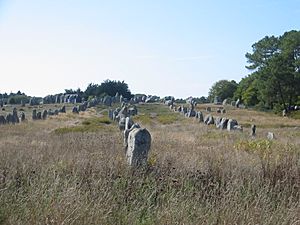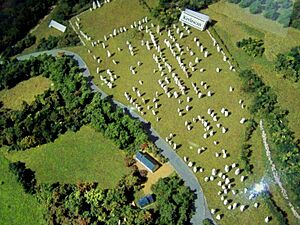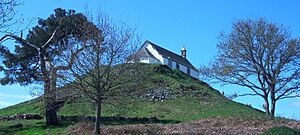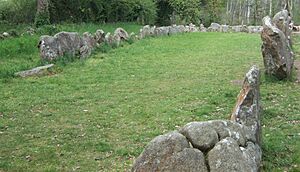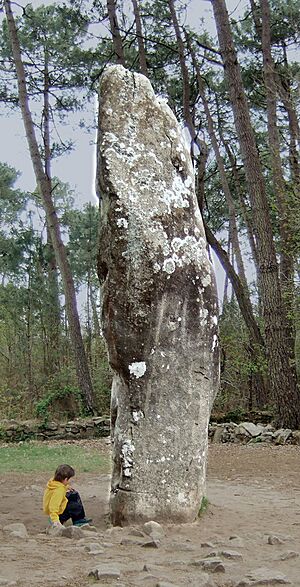Carnac stones facts for kids
The Carnac stones are a huge collection of ancient standing stones. You can find them in Brittany, a region in France. There are over 3,000 of these stones! They were put there by people who lived long before the Celts.
These amazing stones were set up during the Neolithic period. This was the New Stone Age. Most were placed around 3300 BC. Some might even be as old as 4500 BC. The stones are found in different ancient sites near the village of Carnac. They include long rows of stones, called alignments. There are also dolmens (ancient tombs), tumuli (burial mounds), and single standing stones called menhirs.
For many years, people didn't take good care of these sites. Some dolmens were even used as shelters for animals! Stones were sometimes moved to build roads or houses. Today, managing these sites is a big discussion.
Contents
Discover the Carnac Stone Alignments
There are three main groups of stone rows at Carnac. These are called Ménec, Kermario, and Kerlescan. They might have been one giant group long ago. But over time, some stones were taken away.
The Ménec Alignments
This group has eleven rows of menhirs. They stretch for about 1,165 metres (3,822 ft). That's more than a kilometer! At both ends, there might have been stone circles. The stones are tallest at the western end, about 4 metres (13 ft) high. They get smaller in the middle, then grow taller again at the eastern end.
The Kermario Alignments
Further east, you'll find the Kermario alignment. This group has 1029 stones in ten rows. It is about 1,300 m (4,300 ft) long. Pictures taken from the air show a stone circle at the eastern end. The stones here are shorter.
The Kerlescan Alignments
This is a smaller group with 555 stones. It's even further east from the other two. It has 13 lines of stones. The total length is about 800 metres (2,600 ft). The stones here range from 80 cm (2 ft 7 in) to 4 m (13 ft) tall. At the far west, where the stones are tallest, there is a stone circle with 39 stones.
The Petit-Ménec Alignments
This is a much smaller group of stones. It is located even further east than Kerlescan. These stones are now in a wooded area. Many of them are covered with moss and ivy.
Ancient Burial Mounds: Tumuli
There are several tumuli in the area. These are mounds of earth built over graves. In Carnac, they usually have a passage. This passage leads to a central room. This room once held ancient tools and objects.
The Saint-Michel Tumulus
The Saint-Michel tumulus was built between 5000 BC and 3400 BC. It is 125 m (410 ft) long and 60 m (200 ft) wide at its base. It stands 12 m (39 ft) high. Building it needed a huge amount of stone and earth. Its purpose was like the pyramids of Egypt. It was a tomb for important people. Inside, archaeologists found 15 stone chests, pottery, and jewelry. Most of these items are now in the Museum of Prehistory of Carnac.
The Moustoir Tumulus
This tumulus is also known as Er Mané. It is a chamber tomb 85 m (279 ft) long. It is 35 m (115 ft) wide and 5 m (16 ft) high. It has a dolmen at one end. Two tombs are at the other end. A small menhir, about 3 m (10 ft) tall, stands nearby.
Mysterious Dolmens
Many dolmens are spread around the Carnac area. People generally believe these dolmens were ancient tombs. However, the soil in Brittany is acidic. This means that any bones buried there have long since disappeared. Dolmens were built with several large stones. These stones supported a "capstone" on top. Then, the whole structure was covered with a mound of earth. Today, often only the large stones remain. The earth mound has usually worn away or been removed.
- Er-Roc'h-Feutet: This dolmen is to the north. Its roof is still completely covered.
- La Madelaine: This is a large dolmen. It measures 12 by 5 m (39 by 16 ft). It has a broken capstone that is 5 m (16 ft) long.
- Kercado: This is a special dolmen. It is still covered by its original stone mound, called a cairn. It is south of the Kermario alignments. The mound is 25 to 30 metres (82–98 ft) wide and 5 m (16 ft) high. A small menhir sits on top. Inside, many items were found. These include axes, pearls, arrowheads, and pottery. It was built around 4600 BC. People used it for about 3,000 years.
- Crucuno: This is a very famous dolmen. It has a huge capstone that weighs 40 Ton[convert: unknown unit]s! This stone is 7.6 metres (25 ft) long. It rests on pillars about 1.8 m (5 ft 11 in) high.
Other Stone Formations
Besides the alignments, tumuli, and dolmens, there are other interesting stone formations.
The Manio Quadrilateral
This is a group of stones that form a large rectangle. It was originally a mound with a central raised area. It is 37 m (121 ft) long. It is 10 m (33 ft) wide at the east end. It narrows to 7 m (23 ft) wide at the west end.
The Manio Giant
Near the quadrilateral, you'll find a single, huge menhir. It is known as the "Giant." It stands over 6.5 m (21 ft) tall. This giant stone was put back up around 1900. It looks over the nearby Kerlescan alignment.
Images for kids
See also
 In Spanish: Alineamientos de Carnac para niños
In Spanish: Alineamientos de Carnac para niños







